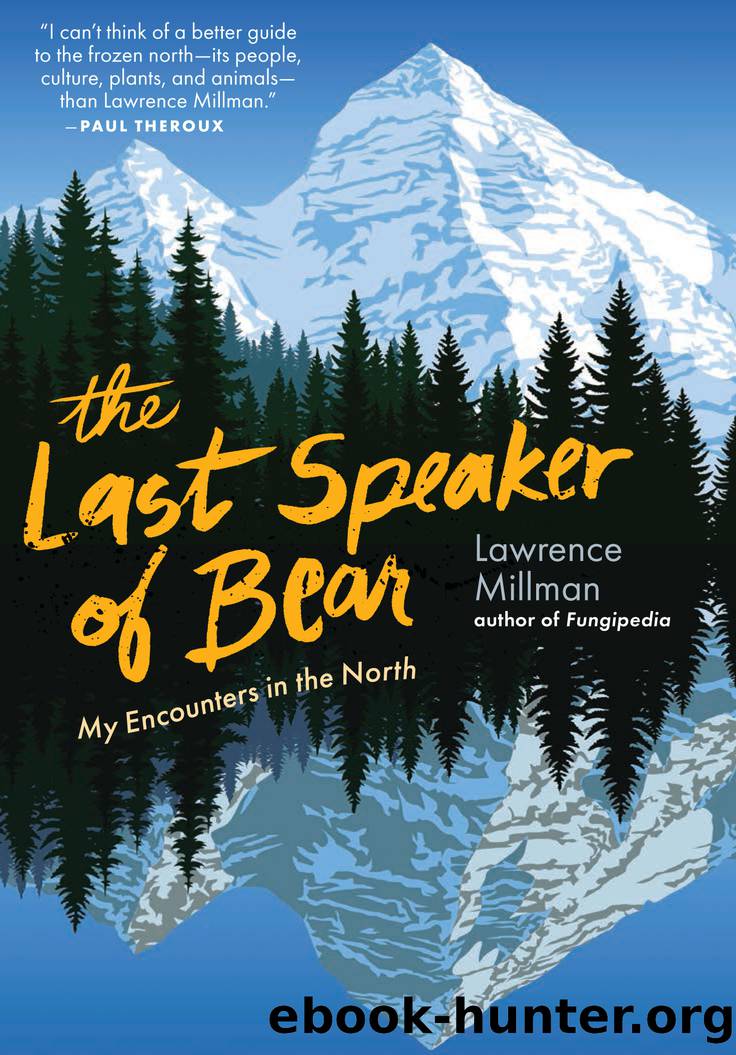The Last Speaker of Bear: My Encounters in the North by Lawrence Millman

Author:Lawrence Millman
Language: eng
Format: epub
Publisher: Trinity University Press
MAKING CONTACT
During the 1980s, I made several visits to Angmagssalik (now Tasiilaq), East Greenland, to collect ethnographic lore from the locals. At one point I asked a hunter if heâd ever encountered any Erqigdlit, a race of doglike people who reputedly lived on or near the Greenland ice cap. Might they be dying out now that the ice cap was melting? I wondered.
The man said heâd never met any Erqigdlit, but he had once gone hunting on a fjord just north of Skjoldungen and found a recently abandoned campsite that had tent rings, discarded skins, and a rock that seemed to be shaped for flensing. This, to him, indicated a group of people still living like their ancestors.
Another local said heâd been to the same place and found a map carved from driftwood that looked exactly like the maps his people carved before the arrival of Europeans.
Why do you think that it was a map and not simply a much-damaged piece of driftwood? I asked him.
âBecause it showed an exact outline of the fjord where I found it,â he said.
Suddenly a lightbulb went on in my mind. An uncontacted group of people living on a remote fjord in southeast Greenland! I decided I would travel down there and try to locate them myself. In the brightness of that same lightbulb, I had an image of a rough-hewn hunter-gatherer staring at me, a visitor from a different era, as if I came from outer space.
I mentioned the prospect of uncontacted Greenlanders to a Danish friend in Angmagssalik. He was no less excited than I. He said the two of us could travel down to the fjords north of Skjoldungen in his motorized fishing boat and search for what he called âthese Stone Agers.â The media, he added, would be really excited if we found them.
Upon hearing the word âmedia,â I began to have my doubts. These doubts increased when I found myself talking again with the man whoâd told me about the driftwood map. âThose unknown people, you must leave them alone,â he said. âLet them live or starve, as they choose. Attuniannaguk! Please donât touch them!â
I now found myself with cold feet. Not the sort of cold feet that a person with the wrong footwear might get in these parts, but a feeling that it wouldnât be a good idea to contact the âunknownâ people. To quote zoologist Konrad Lorenz: âTo kill a culture, it is often sufficient to bring it into contact with another culture, particularly if the latter is higher ⦠or at least regarded as higher.â
In addition to the killing of cultures, contact can literally kill the people in remote cultures. For example, the Sadlermiut in the Canadian Arctic were a more or less uncontacted group of Inuit who were visited by a British whaling ship in 1902. One of the whalers had a case of influenza or perhaps typhoid fever, and he passed on the disease to the Sadlermiut. Only one woman and four children survived this âcontact.
Download
This site does not store any files on its server. We only index and link to content provided by other sites. Please contact the content providers to delete copyright contents if any and email us, we'll remove relevant links or contents immediately.
| Alberta | British Columbia |
| Manitoba | New Brunswick |
| Newfoundland | Nova Scotia |
| Ontario | Prince Edward Island |
| Quebec | Saskatchewan |
| Territories |
Canadians by Roy MacGregor(1156)
Chris Chelios by Chris Chelios(1051)
109 Walks in British Columbia's Lower Mainland by Mary Macaree(1009)
Stone by Stone by Liz Bryan(959)
Berlin Travel Guide by Lonely Planet(918)
I Hear She's a Real Bitch by Jen Agg(907)
Germany Travel Guide by Lonely Planet(894)
Liquor, Lust and the Law by Aaron Chapman(888)
From the Tundra to the Trenches by Eddy Weetaltuk(881)
Moon Atlantic Canada by Andrew Hempstead(838)
105 Hikes in and Around Southwestern British Columbia by Stephen Hui(836)
The Prince by unknow(832)
1,000 Places to See in the United States & Canada Before You Die by Patricia Schultz(827)
Uncle John's Bathroom Reader Plunges into Canada by Bathroom Readers' Institute(825)
Wine by Rod Phillips(817)
DK Eyewitness Top 10 Travel Guides Montreal & Quebec City by DK(798)
How to Move to Canada by Terese Loeb Kreuzer Carol Bennett(789)
Hidden Ontario by Terry Boyle(779)
50 Best Girlfriends Getaways in North America by Marybeth Bond(779)
